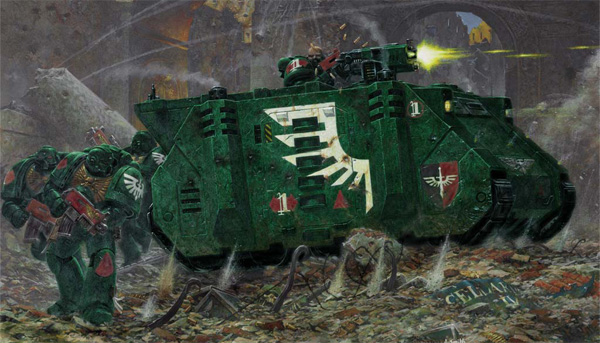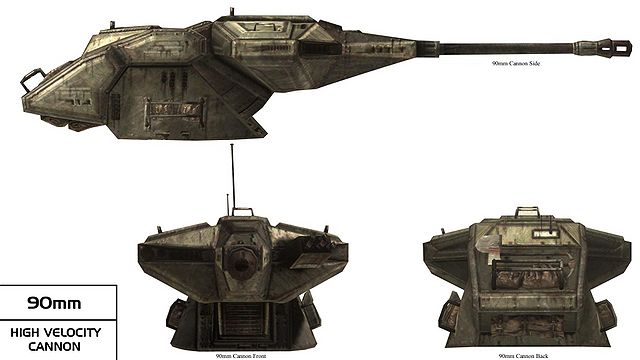 Imperium of Man Rhino Armoured Personel Carrier
Craft: Imperium of Man Rhino Armoured Personel Carrier
Type: Armoured Personel Carrier
Scale: Speeder
Length: 6.6m
Skill: Ground Vehicle operation: Rhino
Crew: 1
Passengers: 10
Cargo Capacity: 1 Tonne
Cover: Full
Maneuverability: 1D
Move: 22; 70kmh
Body Strength: 4D
Weapons:
Storm Bolter
Fire Arc: Front
Skill: Vehicle Blasters
Scale: Character
Fire Control: 2D
Range: 3-50/120/250
Damage: 6D
Description:
The Rhino is a tracked armoured troop produced by the Imperium of Man, its use entrusted to only the most loyal of soldiers: the Space Marines, Sisters of Battle, Adeptus Arbites and the Inquisition. However, the Rhino is also used by their enemies the Chaos Space Marines, having either stolen or taken their Rhinos with them when they rebelled against the Emperor. The Rhino's versatile design has allowed the development (mostly through the rediscovery of STC designs) of several variants, each fulfilling a different tactical role. Popular variants are the Razorback, Predator, Whirlwind and Immolator.
The Rhino has been in service throughout the history of the Imperium. As an Standard Template Construct vehicle, the Rhino dates back to the distant time of Mankind's initial colonisation of the galaxy. Originally named "RH-1-N-0 Tracked Exploration and Multi-Purpose Defense Vehicle," it was used to explore newly colonised worlds. First field-tested on Mars, the Rhino as it came to be known was a success, thanks to its extreme dependability and capability of being produced from any locally available material, as well as make use of any semi-combustable fuel source.
The military value of such a vehicle was discovered, and soon each planet in the small human empire had its own customised versions of the Rhino, fitted with varying weapons.
The earliest evidence of the Rhino in combat was at Torben's World in battle against the indigenous alien population. During the attack, three hundred Rhinos were deployed to the largest alien city. The speed of the assault meant the xenos had no idea of the coming of the humans and had not prepared any defences. The Rhinos poured their firepower into the flimsy structures and then deployed nearly three thousand warriors. The city was destroyed and, with the alien presence removed, the colonisation proceeded easily. The news of this victory spread and the use of the Rhino was adopted more and more by other planets.
As the empire expanded, more aliens were encountered, and the STC system gave a forward army access to advanced vehicles such as the Predator, Immolator and Whirlwind. Unfortunately, during the Age of Strife, the STC systems were lost, and all the planets of the empire were affected.
With the loss of the STC systems, the ability to construct Rhinos was also temporarily lost, leading to many Rhinos becoming holy relics, thousands of years old. Eventually the rediscovery of STC printouts (hard copy blueprints and information on their construction) by the Adeptus Mechanicus allowing the construction of Rhinos to resume.
In the early Imperium, the Rhino was a far more ubiquitous vehicle, employed by most Imperial military forces. Since then, knowledge has faded, and the employment of the Rhino has become limited to the Space Marines and a few other Imperial organisations.
Now, only the Adeptus Mechanicus possess the knowledge to build a Rhino (although a Rhino could easily be built on virtually any world in the Imperium if it possessed a copy of the Rhino design schemes). Each Rhino is purified and blessed, each piece appeased before being put in place. Should a Rhino be lost in battle, it will be salvaged and repaired, being sent back out into the field to give the Machine Spirit a chance for retribution against its enemies.
At its most basic level the Rhino MkIIC is an armoured carrier with large tracks designed to cope with any terrain and protect its passengers from harm. It is such a basic design, constructed from almost any material and powered by any semi-combustible material, that little has changed throughout its 10,000 year history. Such is its resiliency that damaged sustained in battle can often be repaired in the field by the crew themselves.
The Rhino is armed with a Storm Bolter, which is remotely operated by the driver. It can also be equipped with a second pintle-mounted Storm Bolter, which can be fired by a passenger from the top hatch.
The most common form of armouring is a bonded ceramite layer over a cast plasteel hull. However, other materials have been known to be used instead, from composite carbon compounds to conventional hardened steel.
The Rhino is powered by four MkII 'Mars' pattern adaptable thermic combustor reactor engines. The engines are fed by a fan-assisted air intake and each one is hooked into a dynamo, which in turn is connected via power coupling to two electric motors, which power the vehicle's batteries. Each engine also has its own fuel tank and air supply to use if necessary (i.e. fighting in toxic atmospheres or vacuum).3 This level of redundancy means that, should one engine be disabled, power reduction is minimal; if both engines on one side are lost, the remaining two can still power the drive wheels through an auxiliary drive shaft and locking differential, though the Rhino's speed will be cut in half. Should all four engines be destroyed, electrical energy stored in the vehicle's batteries, recharged by the electric motors, can be used to continue operation for a short period of time. In addition, most Rhinos include rudimentary self-repair systems able to restore motive and drive functions. This basic design feature lends towards the Rhino's reputation as a rugged carrier, able to keep moving after suffering damage that would cripple lesser vehicles.
Each Rhino comes equipped with a Searchlight and Smoke Launchers, and can be further upgraded with Dozer Blades, a Hunter-killer Missile and Extra Armour.
The capacity of a Rhino is ten Power Armoured warriors, although it is not equipped to handle Terminator Armour or Jump Pack-equipped Space Marines. Two side hatches and a rear ramp allow for quick exits, while a fourth top hatch allows two passengers to fire from the Rhino, in addition to serving as an emergency escape hatch.
|












